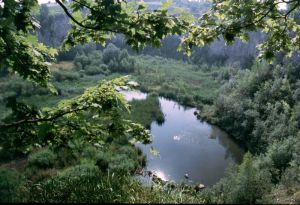|
|
|
It is an abandoned limestone extraction site which represents a great attraction in terms of its landscape, nature, and cultural heritage. During World War II there was a labour camp in this place. At the bottom of the quarry there are two ponds providing sanctuaries for water birds. The remaining surface of the quarry floor is overgrown with moisture-demanding species like reed-mace and willows. Trees flank the northern edge of the quarry. On the same side, behind Swoszowicka street there is a forest complex, again a sanctuary, also for birds-of prey (e.g. common buzzard). The eastern edge of the quarry is treeless, with some remnants of xerothermic swards (of Festuco - Brometea class). Such swards occur also on the slopes of the quarry.

|
|
Water bodies at the bottom of the quarry; phot. Aleksandra Pępkowska
[+] |
The Liban quarry is situated in one of the most valuable areas of the city in terms of landscape and nature. Close to the mound are Krakus mound, complex of ponds near Krakow-Bonarka railway station, Wzgórze Lasoty (hill), Płaszowski Pond and Bonarka nature reserve. The whole area has been proposed by the Foundation for the Support of Ecological Initiatives for designation as a protected landscape-nature complex.
|

